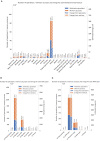A Comparison of Energy-Efficient Seizure Detectors for Implantable Neurostimulation Devices
- PMID: 35317247
- PMCID: PMC8934428
- DOI: 10.3389/fneur.2021.703797
A Comparison of Energy-Efficient Seizure Detectors for Implantable Neurostimulation Devices
Abstract
Introduction: About 30% of epilepsy patients are resistant to treatment with antiepileptic drugs, and only a minority of these are surgical candidates. A recent therapeutic approach is the application of electrical stimulation in the early phases of a seizure to interrupt its spread across the brain. To accomplish this, energy-efficient seizure detectors are required that are able to detect a seizure in its early stages.
Methods: Three patient-specific, energy-efficient seizure detectors are proposed in this study: (i) random forest (RF); (ii) long short-term memory (LSTM) recurrent neural network (RNN); and (iii) convolutional neural network (CNN). Performance evaluation was based on EEG data (n = 40 patients) derived from a selected set of surface EEG electrodes, which mimic the electrode layout of an implantable neurostimulation system. As for the RF input, 16 features in the time- and frequency-domains were selected. Raw EEG data were used for both CNN and RNN. Energy consumption was estimated by a platform-independent model based on the number of arithmetic operations (AOs) and memory accesses (MAs). To validate the estimated energy consumption, the RNN classifier was implemented on an ultra-low-power microcontroller.
Results: The RNN seizure detector achieved a slightly better level of performance, with a median area under the precision-recall curve score of 0.49, compared to 0.47 for CNN and 0.46 for RF. In terms of energy consumption, RF was the most efficient algorithm, with a total of 67k AOs and 67k MAs per classification. This was followed by CNN (488k AOs and 963k MAs) and RNN (772k AOs and 978k MAs), whereby MAs contributed more to total energy consumption. Measurements derived from the hardware implementation of the RNN algorithm demonstrated a significant correlation between estimations and actual measurements.
Discussion: All three proposed seizure detection algorithms were shown to be suitable for application in implantable devices. The applied methodology for a platform-independent energy estimation was proven to be accurate by way of hardware implementation of the RNN algorithm. These findings show that seizure detection can be achieved using just a few channels with limited spatial distribution. The methodology proposed in this study can therefore be applied when designing new models for responsive neurostimulation.
Keywords: convolutional neural network; low-power hardware implementation; random forest; recurrent neural network; responsive neurostimulation; seizure detection.
Copyright © 2022 Manzouri, Zöllin, Schillinger, Dümpelmann, Mikut, Woias, Comella and Schulze-Bonhage.
Conflict of interest statement
The authors declare that the research was conducted in the absence of any commercial or financial relationships that could be construed as a potential conflict of interest.
Figures








Similar articles
-
Memory optimized random forest classifier for EEG seizure detection in implantable monitoring and closed-loop neurostimulation devices.J Neural Eng. 2025 May 27;22(3). doi: 10.1088/1741-2552/add76f. J Neural Eng. 2025. PMID: 40354815
-
A Comparison of Machine Learning Classifiers for Energy-Efficient Implementation of Seizure Detection.Front Syst Neurosci. 2018 Sep 20;12:43. doi: 10.3389/fnsys.2018.00043. eCollection 2018. Front Syst Neurosci. 2018. PMID: 30294263 Free PMC article.
-
Epileptic Seizure Detection on an Ultra-Low-Power Embedded RISC-V Processor Using a Convolutional Neural Network.Biosensors (Basel). 2021 Jun 23;11(7):203. doi: 10.3390/bios11070203. Biosensors (Basel). 2021. PMID: 34201480 Free PMC article.
-
Early seizure detection for closed loop direct neurostimulation devices in epilepsy.J Neural Eng. 2019 Aug;16(4):041001. doi: 10.1088/1741-2552/ab094a. Epub 2019 Feb 21. J Neural Eng. 2019. PMID: 30790780 Review.
-
A Review of Algorithm & Hardware Design for AI-Based Biomedical Applications.IEEE Trans Biomed Circuits Syst. 2020 Apr;14(2):145-163. doi: 10.1109/TBCAS.2020.2974154. Epub 2020 Feb 17. IEEE Trans Biomed Circuits Syst. 2020. PMID: 32078560 Review.
References
-
- Heck CN, King-Stephens D, Massey AD, Nair DR, Jobst BC, Barkley GL, et al. . Two-year seizure reduction in adults with medically intractable partial onset epilepsy treated with responsive neurostimulation: final results of the RNS System Pivotal trial. Epilepsia. (2014) 55:432–41. 10.1111/epi.12534 - DOI - PMC - PubMed
LinkOut - more resources
Full Text Sources
Research Materials

